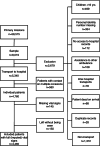Pre-hospital triage performance and emergency medical services nurse's field assessment in an unselected patient population attended to by the emergency medical services: a prospective observational study
- PMID: 32807224
- PMCID: PMC7430123
- DOI: 10.1186/s13049-020-00766-1
Pre-hospital triage performance and emergency medical services nurse's field assessment in an unselected patient population attended to by the emergency medical services: a prospective observational study
Abstract
Background: In Sweden, the rapid emergency triage and treatment system (RETTS-A) is used in the pre-hospital setting. With RETTS-A, patients triaged to the lowest level could safely be referred to a lower level of care. The national early warning score (NEWS) has also shown promising results internationally. However, a knowledge gap in optimal triage in the pre-hospital setting persists. This study aimed to evaluate RETTS-A performance, compare RETTS-A with NEWS and NEWS 2, and evaluate the emergency medical service (EMS) nurse's field assessment with the physician's final hospital diagnosis.
Methods: A prospective, observational study including patients (≥16 years old) transported to hospital by the Gothenburg EMS in 2016. Three comparisons were made: 1) Combined RETTS-A levels orange and red (high acuity) compared to a predefined reference emergency, 2) RETTS-A high acuity compared to NEWS and NEWS 2 score ≥ 5, and 3) Classification of pre-hospital nurse's field assessment compared to hospital physician's diagnosis. Outcomes of the time-sensitive conditions, mortality and hospitalisation were examined. The statistical tests included Mann-Whitney U test and Fisher's exact test, and several binary classification tests were determined.
Results: Overall, 4465 patients were included (median age 69 years; 52% women). High acuity RETTS-A triage showed a sensitivity of 81% in prediction of the reference patient with a specificity of 64%. Sensitivity in detecting a time-sensitive condition was highest with RETTS-A (73%), compared with NEWS (37%) and NEWS 2 (35%), and specificity was highest with NEWS 2 (83%) when compared with RETTS-A (54%). The negative predictive value was higher in RETTS-A (94%) compared to NEWS (91%) and NEWS 2 (92%). Eleven per cent of the final diagnoses were classified as time-sensitive while the nurse's field assessment was appropriate in 84% of these cases.
Conclusions: In the pre-hospital triage of EMS patients, RETTS-A showed sensitivity that was twice as high as that of both NEWS and NEWS 2 in detecting time-sensitive conditions, at the expense of lower specificity. However, the proportion of correctly classified low risk triaged patients (green/yellow) was higher in RETTS-A. The nurse's field assessment of time-sensitive conditions was appropriate in the majority of cases.
Keywords: Emergency medical services; Field assessment; Patient safety; Pre-hospital emergency nurse; Triage.
Conflict of interest statement
The authors declare that they have no competing interests.
Figures
References
-
- FitzGerald G, Jelinek GA, Scott D, Gerdtz MF. Emergency department triage revisited. Emerg Med J. 2010;27:86–92. - PubMed
-
- Fernandes CMB, Tanabe P, Gilboy N, Johnson LA, McNair RS, Rosenau AM, et al. Five-level triage: a report from the acep/ena five-level triage task force. J Emerg Nurs. 2005;31:39–50. - PubMed
-
- Widgren BR, Jourak M. Medical emergency triage and treatment system (metts): a new protocol in primary triage and secondary priority decision in emergency medicine. J Emerg Med. 2011;40:623–628. - PubMed
Publication types
MeSH terms
LinkOut - more resources
Full Text Sources
Medical
Miscellaneous




